Furniture is a vital—if often little noticed—part of modern living. People sit in chairs and sleep in beds . They gather around tables to eat or to play games. Smaller tables hold vases , lamps , and decorative items. People work at desks in offices and schools. Chests with lids, doors, or drawers store and protect clothing. Special cabinets or shelves house electronic equipment and books.
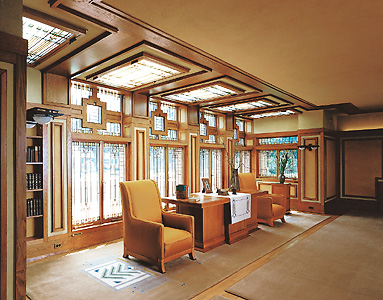
Throughout history, artisans have decorated furniture. The decorations on a piece of furniture often match the style of the building in which the furniture is placed. Furniture may also match the other furnishings in a room, such as rugs, curtains, lamps, and pictures.
People in different parts of the world favor different kinds of furniture. Even in a single place or culture, new styles of furniture develop over time. People who study historical furniture have assigned names to the various periods and styles. In some cases, the styles are named for the reigns of rulers, such as Louis XIV of France . In other cases, styles are named for designers, such as Thomas Chippendale of England . Older styles have occasionally been brought back in revivals long after they were originally fashionable.
For most of history, only royalty and other wealthy people owned fine furniture. Their furniture served to impress others. Kings and queens sat on golden thrones. Heads of families used fancy armchairs. Many museums display such highly decorated pieces of furniture as fine art . Since the 1500’s, more and more people have been able to afford furniture for different uses. Today, people surround themselves with many kinds of furniture. Our furniture serves all our needs for storage, display, and comfortable seating and sleeping.
Early furniture
The ancient Egyptians had developed sophisticated furniture by around 3000 B.C. The ancient Greeks borrowed many of their furniture styles from the Egyptians. The ancient Romans, in turn, further developed Greek styles. In Asia, artisans of China, Japan, and India produced the most noteworthy furniture.
In ancient Egypt.
The ancient Egyptians used woodworking techniques that are still practiced today. Egyptians considered the ownership of furniture a mark of social rank. The richest furniture, often made of ebony , decorated the palaces of Egyptian kings. Members of the nobility, wealthy officials, and landowners also possessed fine furniture. Some furniture has survived inside the great pyramids and other tombs in which rulers were buried.
Egyptian furniture included items that are now common, such as beds and chairs. Most beds sat on legs shaped like the legs of animals, such as lions or leopards. These beds led to the development of couches. The finest chairs had seats of woven cord covered with removable cushions. Other Egyptian furniture included boxes, cabinets, stools, and small tables. The ancient Egyptian standards for the size and shape of their furniture influenced many later cultures.
In ancient Greece.
Ancient Greek civilization began to flourish around 800 B.C. Over the following centuries, the Greeks made many developments in furniture. In ancient Greece, as in ancient Egypt, only people of the highest social rank possessed much furniture. Early Greek furniture forms were influenced by Egyptian styles, but the Greeks began to develop their own approaches. For example, the Greeks developed bedlike couches, which they used for dining as well as for sleeping and resting. During a meal, the diner would lie on the furniture on his or her side, leaning on one elbow for support.
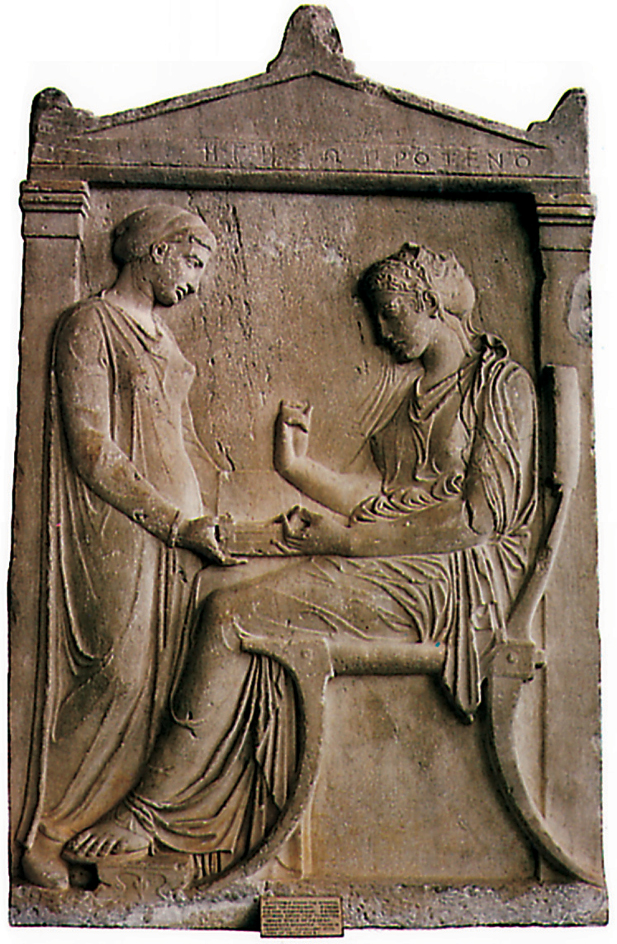
Greeks produced a variety of seating furniture. Most important were the thrones made for the rulers. Some thrones had low backs decorated with carved animal heads. Others had high backs with flowerlike carvings. Arm supports took the form of rams’ heads. The most distinctive type of Greek chair, called the klismos, had curved legs. The front and rear legs curved outward, in opposite directions, at the bottom. Greek artisans made wider use of tables than did the Egyptians. Some of these tables were made of marble or bronze. Many Greek tables had three legs that ended in feet shaped like hooves or paws. Greeks decorated their finest furniture with inlaid patterns of colored wood, silver, gold, and gems.
In ancient Rome.
The Roman civilization flourished from around 700 B.C. to A.D. 400. The Romans borrowed many furniture forms from the Greeks but gave them more elaborate designs. For example, the Romans used more iron, bronze, and silver in their furniture than did the Greeks. Romans adopted the Greek klismos chair but made it heavier and larger. The Romans developed a Greek stool design into a stool called a curule. The curule had two pairs of legs, one in the front and one in the back. The delicate, curved legs in each pair were crossed in the shape of an X.

Tables were popular among the Romans. Many Roman tables rested on three or four legs connected by crossbars called stretchers. The slab table was a major Roman contribution to table design. The tabletop consisted of a large slab of marble or wood supported on carved upright marble slabs. Artisans sculpted various designs into the upright slabs, including animals, flowers, fruits, and vines.
In China.
By the 700’s B.C.—and possibly earlier—Chinese artisans were skilled at making high-quality furniture. One of the most characteristic forms of furniture that developed in ancient China was the kang. A kang was a hollow, raised platform that could be heated by connecting it to a stove. The Chinese used kangs for sitting and sleeping. They also placed small tables on top of the warm platform. Kangs were used for many centuries in various parts of China.

Chinese furniture could be roughly divided into two categories: household furniture and the furniture for royal palaces . Household furniture was simple and practical. Palace furniture was larger, heavier, and more richly decorated. All Chinese furniture was notable for the complex manner in which artisans joined the parts. Chinese artisans seldom used pegs, nails, or glue. Instead, they made use of mortise and tenon joints. Such joints consist of a hole—the mortise—_and a piece that fits into it, called the _tenon. Chinese artisans could fashion mortises and tenons to fit together so tightly that no fasteners or glue were needed. Woven cane was sometimes used for chair seats and tabletops. The Chinese also developed distinctive red and black lacquered furniture. The lacquer was made from tree sap and was painted on the surface in many different coats.
In India.
The earliest important pieces of Indian furniture were designed for the nobility. Common people, by contrast, typically sat and slept on simple cushions and pads on the floor.
Buddhism , a religion that began in India around 500 B.C., spread to China and influenced furniture design there. For example, the chair might have been adopted in China as a result of interactions with Indian Buddhist monks. Simple chairs were often used by Indian monks .
In Japan.
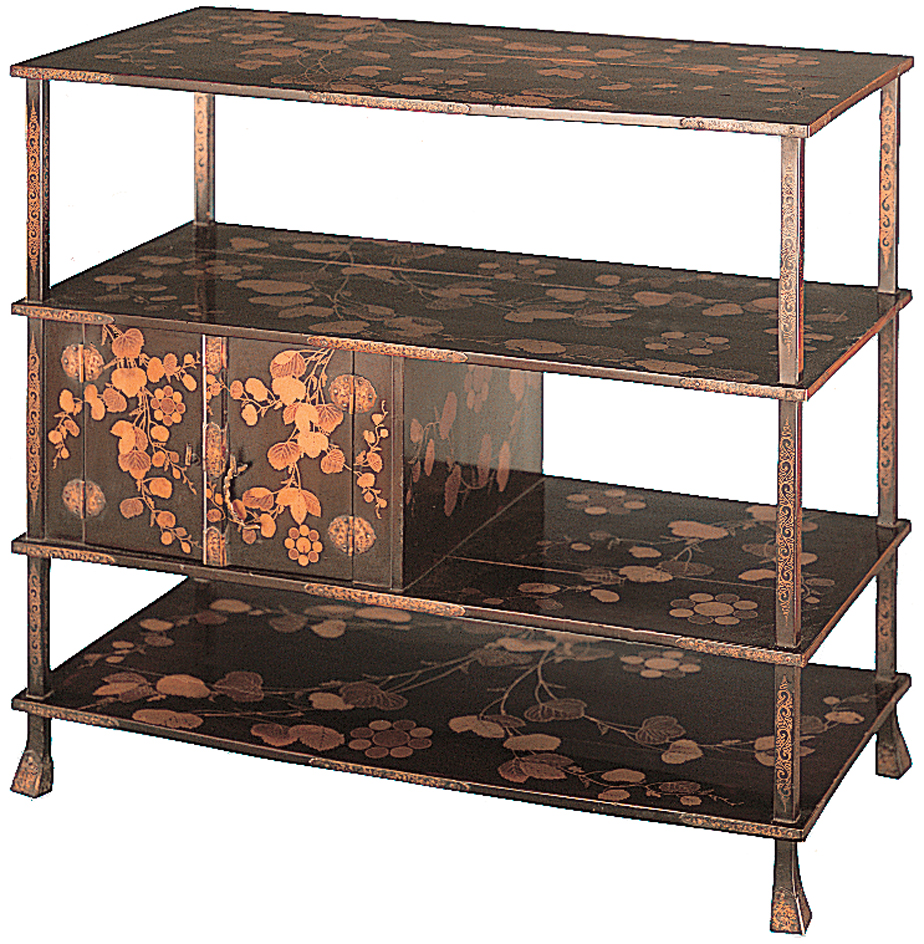
Japanese furniture styles were largely determined by architectural concerns. Earthquakes occur frequently in Japan . To minimize damage and injury from falling structures, ancient Japanese buildings were lightly constructed and usually only had one story. In both homes and palaces, the Japanese used small, lightweight cabinets, chests, writing tables, and folding screens rather than large, heavy pieces. The Japanese customarily sat and slept on floor mats, so they used neither chairs nor beds. Their furniture was simple in shape but skillfully decorated. The best chests and folding screens were colorfully painted with flowers and animals and scenes from Japanese literature. Japanese artisans lacquered the furniture to give it a hard, glossy finish. They also decorated furniture with shell inlays, rich fabrics, and such metal fittings as hinges.
The Middle Ages
The Middle Ages were a period in European history from about the A.D. 400’s to the 1400’s. Few examples of the furniture of this period have survived. As in earlier times, people of high rank owned the finest furniture. Many fancy cupboards and dressers were painted or gilded (coated with gold).
When landowners and church officials of the Middle Ages traveled, they usually carried their furniture and other possessions with them. Furniture makers constructed many items in such a way that they could be taken apart and carried easily. Trestle tables, used for dining, consisted of a removable board placed on two upright supports. Chests for transporting goods had domed tops to shed water. Chests with flat tops served as seats or tables as well as spaces for storage. Powerful heads of households sat in thronelike chairs and slept in large beds with canopies and elaborate hangings. These rarer items were too large to move.
By the 1200’s, Europeans were building churches called cathedrals in a new, elaborate style of architecture called Gothic . Artisans decorated furniture, especially chests and cupboards, with such Gothic details as pointed arches; clustered columns ; quatrefoils (four-lobed cutouts); and tracery , ribbed patterns developed for use in cathedral windows.
The Renaissance
In Europe, the Middle Ages were followed by the Renaissance , a period that lasted from about 1300 to 1600.
The Renaissance was marked by a revival of interest in the so-called classical cultures of ancient Greece and Rome. Classical art and architecture strongly influenced furniture designed during the Renaissance. Italian artisans created some of the first important Renaissance furniture during the 1400’s. Their work attracted much attention throughout Europe, especially in France, England, and Spain . Renaissance furniture styles persisted through the 1600’s.
In Italy.
During the Renaissance, Italian palaces became famous for their luxurious interiors, which included fine furniture and magnificent paintings . These palaces actually contained relatively few pieces of furniture by modern standards. The best-furnished room in a palace was the studio, a library in which the owner kept books, manuscripts, gems, medals, and small sculptures. These items sat on shelves or in the drawers of beautifully ornamented cupboards.
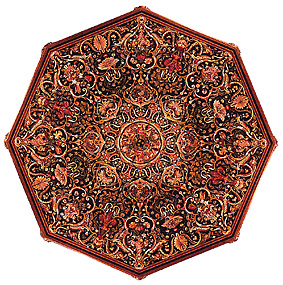
A new type of large chest called a cassone was carved, gilded, and painted with scenes from classical history, the Bible, and Greek and Roman mythology . Another type of chest called the cassapanca developed from the cassone. Used as a sofa as well as a chest, the cassapanca had a backrest and arms. People also sat on chairs with X-shaped frames inspired by the ancient Roman curule, some with cushions and some upholstered. The sgabello was a stool with a back that rested on two solid uprights. Credenzas or sideboards—_long, low tables fitted with doors below the tabletop—also became popular. Artisans decorated these tables with _pilasters (half columns), cornices (roof edges), and other features from classical buildings. Many Italian tables stood on bases modeled after those of the slab tables of ancient Rome. Tops of other tables were made of marble or inlaid wood. These tables rested on bases sculpted in the form of mythical creatures, shells, floral designs, or human figures.
In France.
French Renaissance furniture can be divided into two distinct styles: Francis I and Henry II . Each was named for the reign of a French king. Francis I ruled from 1515 to 1547. Henry II ruled from 1547 to 1559.
Before the reign of Francis I, French furniture reflected the Gothic style of the late Middle Ages. A new style developed after Francis brought leading Italian artists to France to remodel the royal palace at Fontainebleau . In redesigning the palace, the Italians introduced classical designs that revolutionized French art of the period. Mostly derived from classical architecture, the designs included columns, carved human heads surrounded by scrolls, and carved interlacing bands called strapwork.
The Italian-inspired Francis I furniture style lasted until the mid-1500’s. The Henry II style—more varied and more identifiably French—became the dominant style. Carved human figures still played an important decorative role, as did carved animals. Columns and rounded arches supported tabletops. But the new style was made mostly of walnut rather than the oak of older furniture styles. Walnut gave the furniture a lighter appearance.
French artisans redesigned the traditional cabinet by stacking a smaller cabinet on a larger one, topped by a heavy pediment. A pediment is a triangular rooflike design often found in classical architecture. This piece of furniture, called an armoire à deux corps (armoire in two parts), was used to store clothing and other goods. An other French innovation from this period was the caquetoire, an armchair with a wide seat and narrow paneled and carved back.
In England.
The Italian Renaissance influenced England largely because of King Henry VIII , who ruled from 1509 to 1547. Henry invited Italian artists and artisans to work in England. English furniture makers then blended the Italian ornamental style with traditional English designs to create an English Renaissance style. So-called nonsuch chests (a reference to Henry’s Nonsuch Palace) featured inlaid pictures of castles. They were imported from Germany or made by German immigrants.
A number of distinctly English furniture forms appeared during the reign of Queen Elizabeth I , who ruled from 1558 to 1603. One form was the draw table, a large oak dining table made with extensions called leaves that could be drawn out from under the top. Three-tiered court cupboards served as display pieces. Other cupboards were enclosed with doors on the bottom or were open on the bottom and rested on turned legs. Such legs were shaped using a machine called a lathe. The lathe rotated a piece of wood while the wood was cut with chisels or gouges (curved chisels). Cupboards were often draped with colorful cloth.
In Spain.
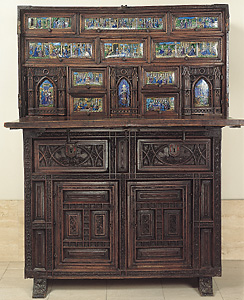
Spain developed a Renaissance style that combined Spanish, Italian, and Moorish influences. Moors were North African Muslims who had invaded Spain in the A.D. 700’s. The Moorish influence on Spanish furniture appeared in an emphasis on gilding and on ivory and wood inlays in geometric designs. These designs, called certosina, were also popular in Italy. A major contribution of Spanish artisans was the vargueno, a portable cabinet that rested on another cabinet or on a stand with legs. The vargueno’s door was hinged at the bottom. When open, the door served as a writing surface. Behind the door were numerous drawers often carved, painted, gilded, or inlaid with ivory or exotic woods. The vargueno served as a model for the French sécretaire à abattant of the 1700’s. This piece of furniture was a desk with a lid that folded down as a writing surface.
In Asia.
In Asia, furniture styles continued to develop and to influence Europeans who traveled to, and traded with, the region. For example, toward the end of the Renaissance, Europeans learned of the lacquered furniture popular in China and Japan. Interest in this technique led Europeans to develop imitations of Asian lacquering.
In India , the Mughal Empire was established in the 1500’s. Indian furniture during this period became much more ornate and elaborate. Thrones developed into large platforms on which nobles sat with their legs folded. The thrones were often surrounded with floral- patterned carpets, giving the impression of flowers growing out of the throne itself.
The 1600’s
During the early 1600’s, most of Europe was engaged in political and religious wars. This warfare hindered the development of the arts in many European countries. Only Italy and the Netherlands enjoyed peace. Italian artisans in particular became an important source of new furniture design. Dutch furniture makers, such as Jan van Mekeren, created cabinets on stands, made of tropical woods and decorated with beautiful floral pictures. The pictures consisted of thin pieces of different colored wood cut out and fitted together like a puzzle. These pictures were then glued onto the surface of the furniture. This process is called marquetry.
In Italy in the 1600’s.
During the 1600’s, many rich Italian merchants built great palaces. These merchants wanted the finest furniture, and Italian artisans supplied it. Sculptors produced some of the most extravagant—and expensive—furniture, often with carved human figures for the legs of cabinets, stands, and chairs. Filippo Parodi, for example, crafted an elaborate mirror frame featuring a sculpture of Narcissus , a handsome youth in Greek mythology who became entranced with his own reflection in a pond.
Other Italian artisans created fashions for chests, cabinets, and cupboards, and these fashions spread throughout Europe. The cassone of the 1500’s was replaced by two new storage pieces. One was a tall, two-door cabinet or wardrobe. The other was a cabinet or chest with drawers that rested on a stand. Both were lavishly decorated with carvings or pieces of marble fitted together to make pictures or patterns.
In France in the 1600’s.
King Henry IV , who reigned from 1589 to 1610, established royal furniture workshops at the Louvre , a palace in Paris . He brought leading artisans from other countries to work there.
In 1643, Louis XIV became king of France. He was only four years old. He took control of the French government in 1661, after the death of France’s chief minister, Cardinal Jules Mazarin . Louis, who was then 23 years old, devoted himself to making France the cultural and political center of Europe. He used furniture and the decorative arts to glorify his position as king. He turned a building on the outskirts of Paris into the Gobelins workshops, staffing the shops with expert artisans. He commissioned them to create furnishings for his residences. These furnishings inspired a new national style of art.
The artisans worked almost entirely on a single project in Versailles , where they converted a royal hunting lodge into a luxurious royal palace. Among the most impressive parts of the new palace was the Hall of Mirrors. The ceiling is decorated with paintings glorifying the achievements of Louis XIV. The Hall of Mirrors originally contained impressive silver furniture, but these pieces were later melted down.
The remarkable style of the furnishings made for the Palace of Versailles became known as the Louis XIV style. André-Charles Boulle produced some of the most ornate cabinets, chests, and tables in this style. He decorated his furniture with sculptural brass castings (pieces shaped in molds) and detailed marquetry of flowers and other designs. Boulle often decorated his furniture with different colored woods and tortoise shell and inlays made of thin pieces of such metals as brass and pewter.
The French influence spreads.
The furnishings of Versailles set the standard for other royal palaces. Soon French styles were imitated in palaces throughout Europe. Political and religious factors also contributed to the spread of French influence. Although the national religion of France was Roman Catholicism , many French artisans belonged to Protestantism , a rival sect. The French Protestants, called Huguenots , enjoyed some religious freedom under the Edict of Nantes , which King Henry IV issued in 1598. In 1685, Louis XIV took away this freedom by canceling the edict. Most of the artisans then fled to England, the Netherlands, or cities in what are now Germany and Switzerland . There, they worked among the nobles and wealthy merchants, establishing a taste for French design in those places.
Daniel Marot became one of the most influential Huguenot designers, first in the Netherlands and then in England. Marot worked for William III , who was a Dutch prince before he became ruler of England along with his wife, Mary, in 1689. Marot designed the interiors and furniture for the king’s palace at Hampton Court near London. His designs created a demand in the late 1600’s for heavily carved, high-backed chairs with French-style upholstered seats and backs. Marot also designed state beds set aside for use by the king in the main rooms or bedrooms of castles or large houses. Rich silk, velvet, and other expensive fabric hung from a tester (canopy) over the bed.
Other furniture styles that spread widely during this period included three-legged stools and candle stands. Having three legs kept the furniture stable on uneven floors. Dining tables with folding leaves also became popular. Press cupboards, with upper and lower sections enclosed by doors, served as storage. Clothes presses with long doors held clothes.
The 1700’s
French and British artisans dominated furniture design during the 1700’s. Furniture makers throughout Europe and in America reinterpreted the French and British designs, developing them into individual national styles.
French styles.
French furniture went through several distinct styles during the 1700’s. The Régence and Rococo styles elaborated on the ornate Louis XIV furniture. Later, the Neoclassical style featured simpler, straighter designs.
The Régence style
of the early 1700’s was named for the regent (temporary ruler) who governed France during the period. After Louis XIV died in 1715, his 5-year-old great-grandson became King Louis XV . Because the king was so young, his uncle, the Duke of Orleans , was appointed regent. The duke disliked the formality of Versailles and moved the royal court to Paris. There, a less ceremonial lifestyle developed. People of the court moved into smaller and more intimate town houses. The style of furniture created by the French artisan Charles Cressent and others for these town houses became known as the Régence style.
Régence furniture emphasized curves and delicate floral marquetry. It was lighter and more graceful than Louis XIV furniture. Perhaps its most important characteristic was the cabriole leg. Popular in classical times, the cabriole leg mimicked the S shape of an animal’s leg.
The Louis XV Rococo style.
During the 1730’s, the Régence style took on the features of a new style called Rococo. One of the leading designers of Rococo objects was Juste-Aurèle Meissonnier. His designs stressed S shapes, irregular outlines, asymmetrical designs, and carvings of vines and shells. Asymmetrical figures have sides that are not mirror images of each other. The name Rococo came from the word rocaille, which referred to rock-and-shell designs found in artificial caves built in gardens of the time. One of the grandest pieces of furniture in this style was the desk of Louis XV at Versailles. The French cabinetmaker Jean-François Oeben started work on the desk in 1760, and his pupil, Jean-Henri Riesener, finished it nine years later.
The renowned German cabinetmakers Abraham Roentgen and his son David built complex mechanical furniture. They sold it to royalty in France and all over Europe.
Rococo furniture blended with the overall architectural plan of a room. For example, artisans built tables, mirrors, benches, and beds so that they could be set into wall niches designed by the architect. Asian furniture also influenced Rococo design. The style called chinoiserie, loosely based on Chinese designs, flourished. Imported Asian lacquer work also had become fashionable, but it was expensive and hard to obtain. Europeans imitated the Asian lacquer finish using a process called japanning.
The Louis XVI Neoclassical style
replaced Rococo by the late 1760’s. Neoclassical design reflected a new interpretation of ancient Greek and Roman styles. Neoclassical designers gradually eliminated the many curves of the Rococo style in favor of the straight outlines of classical furniture. In place of elaborate Rococo decoration, Neoclassical artisans favored geometric and pictorial marquetry. The new discovery of ancient Roman ruins during the 1700’s also inspired Neoclassical design. The ruins—which included the cities of Pompeii and Herculaneum —had lain buried in ash and cinders spewed from a volcanic eruption in A.D. 79.
British and American styles.
In the British North American colonies , furniture generally reflected the styles that were popular in the United Kingdom . During the 1700’s, such furniture styles drew heavily on the architecture of classical Rome. A book on classical architecture by the Italian architect Andrea Palladio , who lived during the 1500’s, served as a major influence. British and American designers, notably the English architect William Kent , adopted elements of Palladio’s style that were based on Roman architecture. For example, British and American designers decorated chests and cupboards with such architectural features as columns, cornices, and pediments, which had topped buildings in classical times.
English and American furniture from the 1600’s was called Jacobean after the Latin name for King James I , who ruled England early in the century. Oak, riven (split) rather than sawn, was the favored wood. Cupboards for display and storage were the most impressive pieces. By 1700, the William and Mary style—named after the king and queen of England in the late 1600’s—had become popular. Turning replaced carving as the most popular embellishment. The best furniture used sawn walnut.
The Queen Anne style—
named after a queen who reigned from 1702 to 1714—saw the introduction of mahogany, the cabriole leg, and the ball-and-claw foot into British and American furniture design. Curves replaced the straight, carved backs and turned legs of the William and Mary style. The highboy (a high chest with drawers set on tall legs) and matching lowboys (dressing tables) were among the most impressive pieces. The stacked chest-on-chest design replaced the highboy in popularity in England about 1750. In America, however, the highboy remained popular until the end of the century.
Georgian and Chippendale furniture.
By the mid-1700’s, British and American furniture had become more angular. Elaborate, Rococo-style carving often covered furniture surfaces. In 1754, The Gentleman and Cabinet-Maker’s Director, by the English cabinetmaker and furniture designer Thomas Chippendale , was published. The book was devoted entirely to furniture designs. Chippendale did not create any fundamentally new styles. Instead, he merged elements of existing styles. But he portrayed existing styles—especially the Rococo—so thoroughly that cabinetmakers throughout the United Kingdom and America often copied his work. His influence spread so widely that the name Chippendale is often used to refer to all American Rococo furniture of the mid-1700’s. In the United Kingdom, however, the style is called Georgian after George II, who ruled during this period.
English Neoclassical furniture.
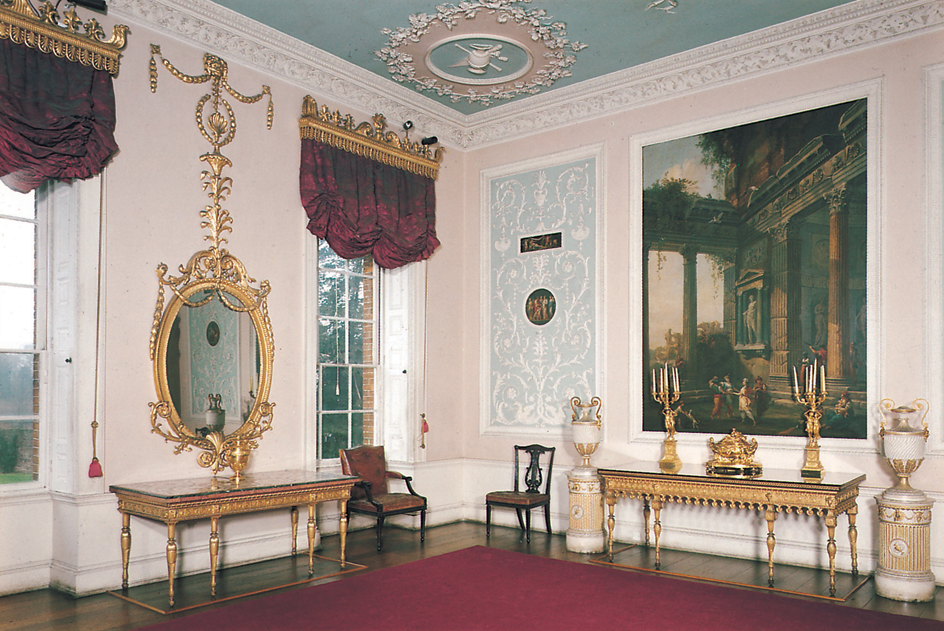
Robert Adam , a Scottish architect and furniture designer, helped popularize the Neoclassical style in the United Kingdom in the 1760’s. After traveling to ancient Roman sites in Europe, Adam developed a new interpretation of classical styles. In the 1700’s, furniture had been inspired by the exterior architectural elements of classical structures, particularly the designs of the five different styles of classical columns. Adam, however, studied the interiors of these classical buildings. As a result, he promoted a more integrated form of Neoclassicism that became known as the “Adam style.” He often painted his furniture or decorated it with floral inlays, particularly the bellflower. This four-petal flower grew wild around the Mediterranean. Adam introduced the sideboard (a cabinet with drawers resting on tall legs) into British and American dining rooms. His ideas were popularized all over Europe and in America through books of furniture designs by the Englishmen George Hepplewhite and Thomas Sheraton .
The 1800’s
Not until after the American Revolution (1775-1783) did the British Neoclassical style come to America. It is now known as the Federal style. The name refers to the Federalist Party , which controlled the government in the early years of the republic. Duncan Phyfe , the leading American furniture designer of the period, worked in New York and helped make it a major center for the Federal style and other furniture designs. Artisans in Boston—notably John Seymour and his son Thomas—and in Salem; Philadelphia; Baltimore; and Charleston, South Carolina, also produced high-quality furniture.

The Empire style
originated with Napoleon Bonaparte, who ruled the French empire until 1815. Empire-inspired furniture was also popular in America into the 1820’s. Like Louis XIV, Napoleon used furniture as a symbol of his political power. Empire furniture designed by his personal architects, Charles Percier and Pierre Fontaine, was impressive—large, heavy, and sculptural.
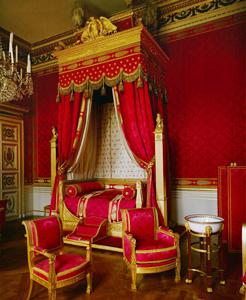
By 1810, craftsmen were making actual copies of Greek and Roman furniture, such as the klismos chair and curule stool. Empire furniture came to resemble sculptural artwork. Furniture makers enlivened their works with carvings of classical subjects such as cornucopias (horns filled with fruit), sphinxes (creatures with human heads and lion bodies), and female figures called caryatids . Empire chests, writing tables, and new desk forms called secretaries were designed to complement the overall plan of a room. Secretaries replaced the desk and bookcase combination of the 1700’s. The new kind of desk featured a drawer that pulled out with a front face that folded down to provide a writing surface.
The Regency style

—not to be confused with the earlier French Régence style—became fashionable in the United Kingdom during the early 1800’s. It was named for the period from 1811 to 1820, when the Prince of Wales served as regent for King George III . The Regency style was similar to the Empire style in France and America. Most Regency furniture combined Egyptian, Chinese, and Gothic motifs (features) with Neoclassical elements. Couches and sofas had arms shaped like scrolls. Chairs loosely modeled on the klismos were popular. Regency artisans used little carving.
Biedermeier and Restauration styles.
After the defeat of Napoleon in 1815, two similar yet independent styles developed in Europe: Biedermeier and Restauration. Both were more informal than the Empire style and were favored by the rising middle class . Another similar style, called Grecian, developed in the United States in the 1820’s and the 1830’s.
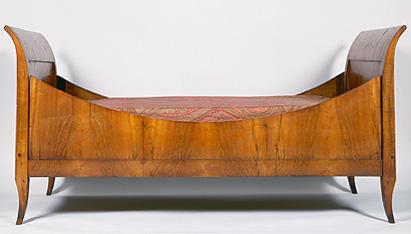
The Restauration style was popular in France from the restoration of the French monarchy in 1815 to the July Revolution of 1830. Restauration furniture was based on the straight outlines of Empire designs and was heavy in appearance. Veneers and inlays often covered the furniture. The complex grain patterns of veneers, particularly of mahogany, served as the chief decoration. Classical designs such as carved swans, lyres, and acanthus leaves further enlivened the furniture.
The Biedermeier style was popular in Austria and Germany from 1820 to 1850, particularly among the growing middle class. The style was named for a comic character in German popular literature. Like Restauration furniture, Biedermeier furniture was based on French Empire forms and was also usually covered with light-colored veneers. But the German style was lighter, simpler, and more geometric in shape. Classical inlays in dark wood embellished some Biedermeier furniture.
Victorian furniture.
Classical and Neoclassical influences had dominated furniture design since the Renaissance. By the early 1800’s, a reaction against such classicism had developed. Victorian furniture—named for the reign of Queen Victoria , who ruled the United Kingdom from 1837 to 1901—directly rejected classical design. Irregularity replaced the smooth profiles of classical furniture, and asymmetry replaced symmetry.
Many novel furniture forms developed. They included beds hidden in cabinets; lightweight shelves called whatnots or étagères to display collectibles; and a small rack called a Canterbury that held sheet music. Chairs made of cast iron, horn, papier-mâché (paper and paste), or wire became common. Also popular were matched seven-piece parlor (living room) sets with a sofa, an armchair, and side chairs. The Thonet Company of Austria produced chairs made of wooden parts that were softened by steam and then bent around forms. Millions of these parts were shipped around the world and assembled at their destination for sale.
Beginning with London’s Great Exhibition in 1851, many world’s fairs were held throughout Europe and the United States. At these fairs, furniture makers from many countries displayed their own designs and viewed the designs of others. The fairs were widely influential and helped to establish an international furniture style. Magazines featuring furniture designs also spread styles worldwide. As a result, furniture manufacturers all over Europe and the United States adopted the same major styles, with some regional differences.
Furniture manufacturing became a major industry in the United States in the mid-1800’s. Steam-powered and water-powered machinery replaced hand tools. Large factories produced huge quantities of furniture that a growing middle class could afford. The Midwest became the chief furniture-producing region because of its abundant supply of hardwoods, access to water power, and convenient railroad transportation. Chicago , Cincinnati , and St. Louis developed into important furniture manufacturing cities. The first furniture factory opened in Grand Rapids , Michigan, in 1848. By the end of the century, Grand Rapids had become the most famous furniture center in the United States.
Historical revivals.
From the 1830’s to the late 1800’s, a number of earlier furniture styles were revived. The most important were the Gothic, Rococo, and Renaissance revivals. Reproductions of American colonial furniture also became fashionable after Philadelphia’s Centennial Exposition in 1876, which marked the 100th anniversary of the signing of the Declaration of Independence . Wealthy homeowners might use each style in a particular room. They might furnish the library in Gothic style, the parlor and bedroom in Rococo, and the dining room in Renaissance Revival. The Gothic style was particularly popular in the United Kingdom. A Gothic variation with many turnings called the Elizabethan Revival became common. The French called Gothic Revival the Troubadour style.
The Rococo Revival replaced the Gothic Revival in the 1840’s. Chairs and sofas in the new style featured cabriole legs and oval- or balloon-shaped backs based on the Louis XV style of the late 1700’s. Artisans decorated furniture with elaborate carvings of fruits and flowers. John Henry Belter, a German-born artisan who moved to New York, produced some of the most ornately carved American furniture in this style.
The Renaissance Revival began in the court of Emperor Napoleon III , who ruled France from 1852 to 1870. Its greatest popularity was in the late 1860’s and the 1870’s. Artisans of this period tried to reproduce the furniture designs from the 1400’s and 1500’s. Elaborately carved Renaissance Revival sideboards served as the centerpieces in dining rooms. Louis XVI furniture, with its straight, classical lines and richly upholstered chairs and sofas, also influenced designers of the period. Coil springs replaced feathers and other natural materials used in earlier periods to stuff seat cushions.
In the mid-1800’s, furniture designers reacted against elaborately decorated furniture. In England, William Morris and other reformers wanted to return to a period of hand craftsmanship that preceded the Industrial Revolution , a period of rapid technological change that began in the late 1700’s. They rejected machine-made furniture and advocated furniture with minimal ornamentation. Morris and others gave birth to the Arts and Crafts movement, which looked back to the handmade furniture of the Middle Ages. The expense of handmade furniture limited its appeal, but many of the movement’s ideas influenced the popular Queen Anne Revival and the Eastlake style. The Eastlake style was named for Charles Locke Eastlake, who popularized the style in his 1868 book, Hints on Household Taste in Furniture, Upholstery, and Other Details.
Other manufacturers found inspiration in Japanese design. The Herter Brothers company in New York produced some of the most inspired furniture in this style. Their best art furniture was made for newly rich industrialists. It often featured stylized floral marquetry set against lacquered surfaces.
Art Nouveau,
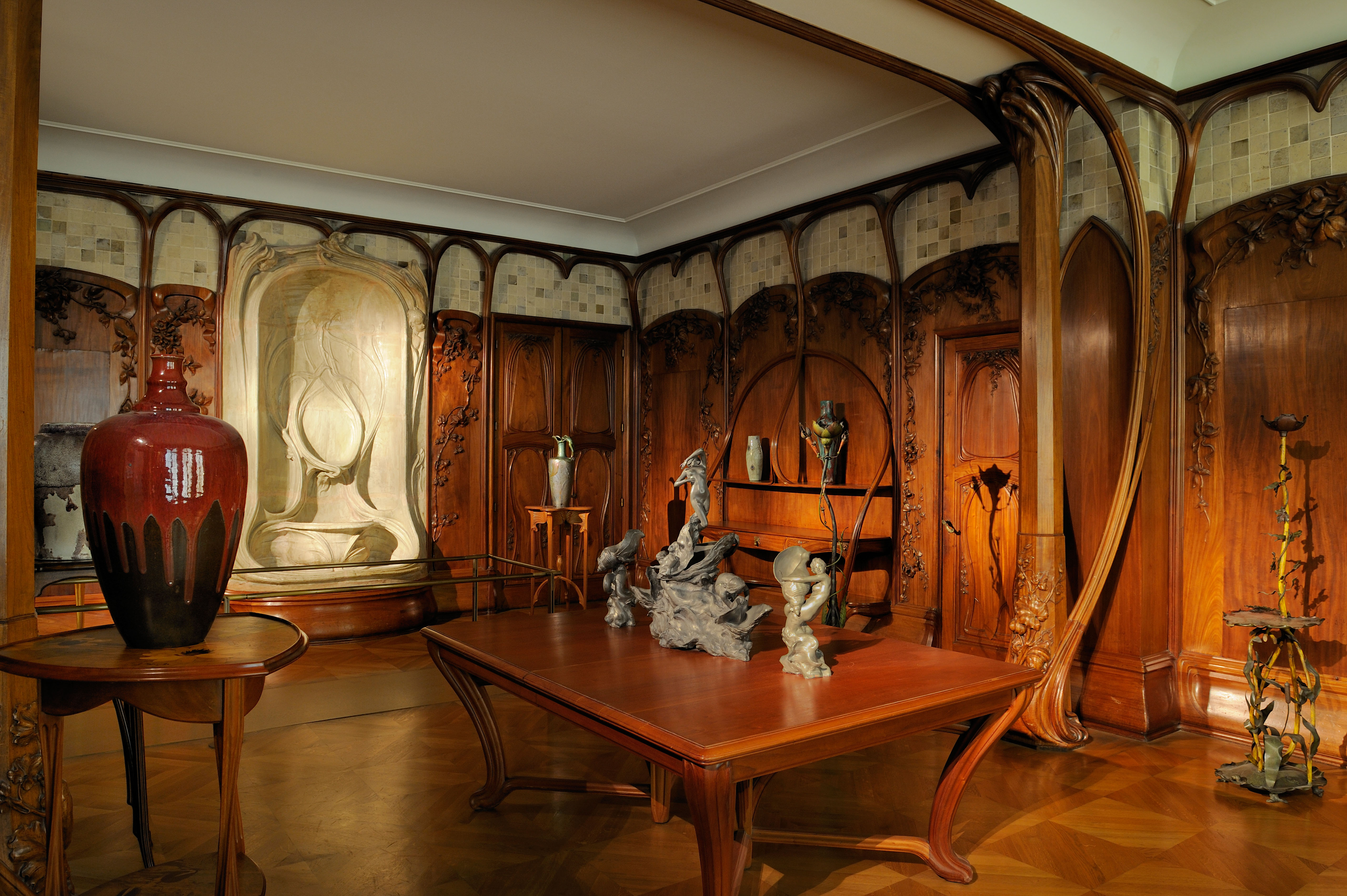
French for new art, developed as a revolt against historical revivals. This movement began in the late 1800’s and lasted until the early 1900’s. Art Nouveau furniture took inspiration from such natural objects as blossoms, roots, stalks, and vines. Practitioners of Art Nouveau, such as French artists Emile Galle and Louis Majorelle, often combined these motifs with a graceful curve called a whiplash. Art Nouveau took different forms in different European countries. Geometry served as an inspiration in the work of Charles Rennie Mackintosh of Scotland, Josef Hoffmann of Austria, and Frank Lloyd Wright of the United States. Whether based on nature or geometry, Art Nouveau sought to break with tradition and helped usher in the modern age of furniture.
The 1900’s and 2000’s
Although historical revivals continued through the 1900’s, many designers rejected this approach. They adopted new designs and new materials that revolutionized both the appearance and the production of furniture. By the 1900’s, many manufacturers employed materials other than solid wood to make furniture. Such materials included steel , aluminum , plastic , plywood , and glass .
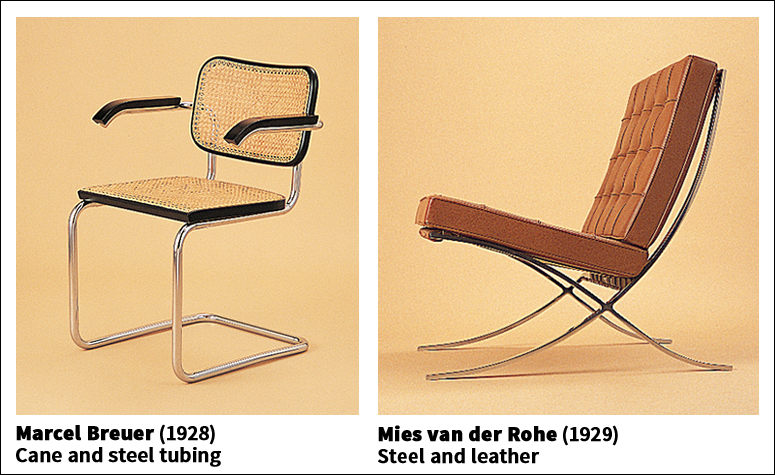
Modern furniture reflected three new approaches to design. One approach was based on geometric forms often made of chrome-plated steel strips or tubing. This style developed at a school in Germany called the Bauhaus . Another style featured forms with softly swelling and rounded shapes resembling tree trunks, plant roots, or other living organisms. But instead of metal, this approach featured natural woods such as teak or walnut. This style originated in the Scandinavian countries, notably Sweden, Denmark, and Finland. A third approach was based on modern, abstract art movements. This furniture took on shapes with bulbous and irregular forms found in the work of such Spanish artists as Joan Miró and Salvador Dalí . Most modern furniture had little decoration.
By the late 1900’s and early 2000’s, local furniture movements had been replaced by international styles available around the world. Furniture in general had shifted from a luxury item to a mass-produced, functional product found in every home and workplace.
De Stijl,
Dutch for the style, was a movement that began in the Netherlands about 1917. The De Stijl movement produced furniture that emphasized abstract, rectangular forms, such as those made by the Dutch architect and furniture designer Gerrit Rietveld. The pure geometry of De Stijl furniture and the lightness and clarity of the designs influenced later styles.
The Bauhaus
was founded in 1919 by the German architect and educator Walter Gropius . The school made important contributions to furniture design in the 1900’s. The Hungarian-born architect Marcel Breuer , a Bauhaus furniture instructor, experimented with tubular steel to make chair frames. Produced by machine, chrome-plated steel tubing could be bent into simple, elegant frames that required little hand-finishing or upholstery. Steel tubing thus produced stylish appearance at a greatly reduced cost, achieving a major goal of modernist designers. Breuer’s tubular steel Wassily chair is named after the artist Wassily Kandinsky , who greatly admired the piece.
Ludwig Mies van der Rohe , the last director of the Bauhaus, was known for his cantilevered (supported on one side) tubular steel chairs. In 1929, he also created the Barcelona chair for the Spanish pavilion at the International Exposition in Barcelona . A curved, flat steel frame supported removable leather back and seat cushions. The chair’s X-shaped legs resembled those of the ancient Roman curule stool. Repressed by the Nazi government, the Bauhaus closed in 1933, forcing many Bauhaus teachers to emigrate. They carried with them their modern ideas of furniture design, spreading the influence of the Bauhaus internationally.
The American architect Frank Lloyd Wright and his followers believed that furniture should relate comfortably to its surroundings. To accomplish this, Wright reduced furniture to basic geometric shapes. Often he derived these designs, mostly crafted in oak, from the plain outlines of Japanese furniture. Because Wright created his designs for a specific setting, they were typically neither interchangeable nor movable. They were also often expensive.
Art Deco
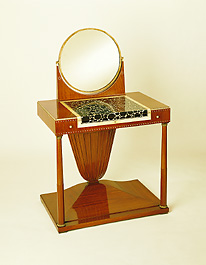
was the most popular international decorative style in the 1920’s and 1930’s. Art Deco stressed streamlined, geometric forms. These shapes reflected widespread interest in objects that suggest speed—such as automobiles, trains, and airplanes. Designers blended brushed steel and other industrial products with such traditional luxury materials as ivory, shagreen (sharkskin), and exotic woods to produce elegant furniture. Art Deco combined such diverse influences as machine design with ancient Egyptian, Native American, and African art. During the 1920’s, the French designer Émile-Jacques Ruhlmann—also known as Jacques-Émile Ruhlmann—produced some of the most luxurious furniture in this style
Scandinavian design
emerged in the late 1920’s as an alternative to the luxury furniture of the Art Deco style and the machine-inspired Bauhaus designs. Kaare Klint, a Danish architect and designer, became one of the first leaders of the modern Scandinavian style. The Finnish architect Alvar Aalto also designed innovative bent plywood furniture in this style. Other prominent Scandinavian designers, such as Hans Wegner, favored clean, plain designs using unpainted woods. This furniture style enjoyed wide appeal because it was warm, natural, and easy to maintain. It fit comfortably in modern apartments and smaller homes. By the late 1940’s, Scandinavian design had become one of the primary trends in furniture. It remained popular in Europe and America into the mid-1960’s.
After the end of World War II (1939-1945), the Southeastern United States replaced the Midwest as the leading American furniture-making region. At the same time, large international furniture manufacturers replaced many of the thousands of small businesses that once dominated the furniture trade. Two of the most prestigious and influential of these companies were Knoll International, founded in New York in 1938 by Hans Knoll, and Herman Miller, based in Zeeland, Michigan. These international firms commissioned experimental and original furniture from the leading industrial designers and architects of the day. These included the Americans Charles and Ray Eames , George Nelson, Isamu Noguchi , and Warren Platner; the Italian-born Harry Bertoia; and the Finnish-born American Eero Saarinen .
Mid-Century Modern,
also called Retro, refers to the styles of the prosperous years of the 1950’s and 1960’s, following World War II. At this time, American designers dominated the modern furniture world. An icon of the Retro style was the chair created by Charles and Ray Eames. Its shieldlike molded plywood seat and back were attached via rubber disks to a thin frame of chrome-plated, tubular steel rods. The disks permitted the seat to shift with the weight of the sitter, eliminating the need for traditional upholstery.
Retro armchairs took on dramatic organic (natural) forms, as famously seen in the womb chair, designed by Eero Saarinen in 1947. It was the first chair with a molded plastic seat, although fabric covered the rough plastic shell. A year later, Eames created the DAR (_d_ining _a_rmchair _r_od). It had a smooth plastic surface that did not need to be covered. In 1957, Saarinen designed his celebrated tulip chair, with a molded fiberglass seat supported on a slender aluminum pedestal. Isamu Noguchi’s coffee table had a glass top shaped like a boomerang. Its wooden base was _biomorphic—_that is, shaped to resemble living forms. This table typified the organic, minimalist approach to design. The Japanese designer Kazuhide Takahama’s biomorphic Suzanne sofa of 1965 used large chunks of polyurethane foam.
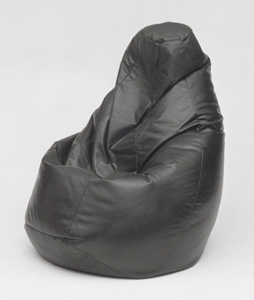
In the 1960’s, to reduce reliance on increasingly costly materials, designers pioneered the concept of disposable furniture. A famous example was the inflatable plastic “Blow” chair of 1967, designed for the international firm of Zanotta in Milan, Italy. The 1968 sacco chair or beanbag chair, also designed for Zanotta, was another example of this type of furniture. It was a simple leather or cloth sack filled with plastic beads that adjusted to the movements of the sitter’s body. Before he became world famous, the American architect Frank Gehry used cardboard to make his set of Easy Edges seating furniture in 1972.
Postmodern design
of the late 1900’s included the rediscovery of decoration. Many architects, including Robert Venturi in America and Ettore Sottsass in Italy, tried their hand at furniture design in the Postmodern style. They combined Classical and Renaissance styles with such 1900’s movements as Art Deco and popular, mass-produced art from the postwar period. Much Postmodern furniture made use of speckled Formica—a board with a thin plastic veneer fashionable in the 1950’s—in soft rose, mauve, and blue.
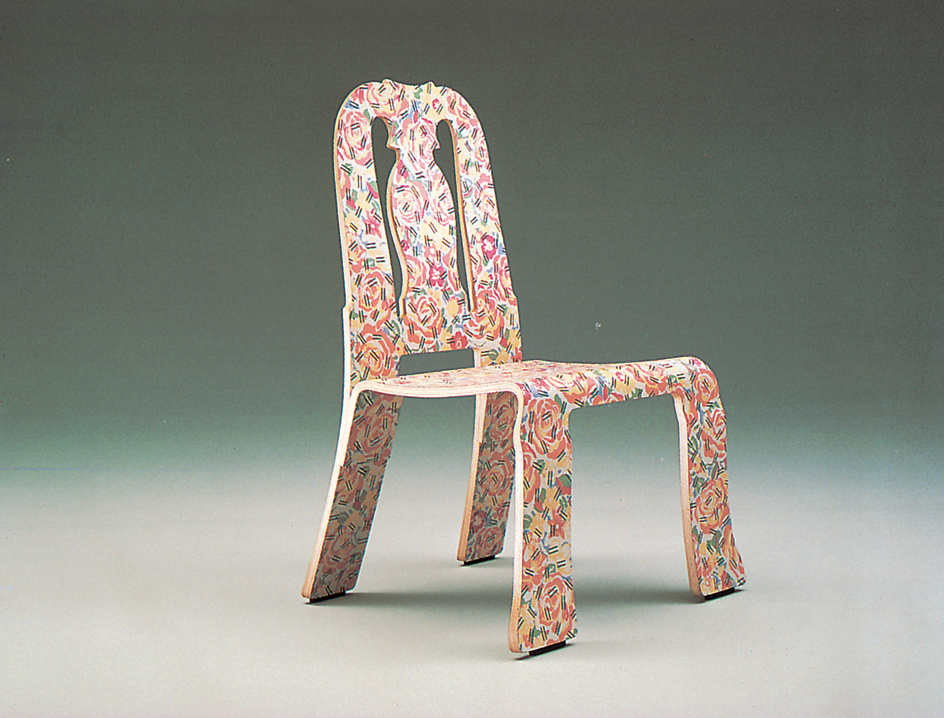
Venturi’s bent plywood Queen Anne, Sheraton, and Art Deco chairs for Knoll International exemplified Postmodern design concepts. Viewed in profile, they appeared simply modern. Turned forward, they revealed the outlines of traditional 1700’s chair styles. The result was an almost whimsical reinterpretation of historical models. In the early 1980’s, Sottsass and the Italian firm Memphis also popularized Postmodern design with a line of case and seating furniture, clocks, and lighting.
Even as factory-produced furniture became widespread, handcrafted furniture based on an antimachine philosophy saw a revival. Since the 1950’s, such artisans as the Americans Wendell Castle and Sam Maloof and the Englishman John Makepeace skillfully crafted furniture that machines could not easily reproduce. These designers sought to revive hand craftsmanship and the late 1800’s ideals of the Arts and Crafts movement. Similarly, industrial designers such as the Australian Marc Newson produced limited production work. Newson’s Lockheed Lounge, with a riveted skin like an airliner, was appreciated more as art than as functional furniture.
In the 2000’s, IKEA became the largest furniture seller in the world. Founded in Sweden in 1943, the company operates hundreds of stores in more than 40 countries. Its furniture products are typically modernist, with simple and functional designs. The company has kept prices low by selling furniture parts bundled in flat boxes to be assembled by the customer.
